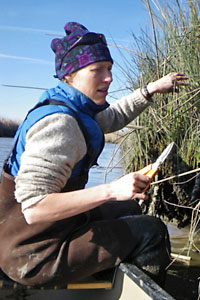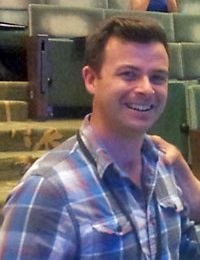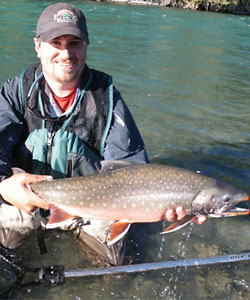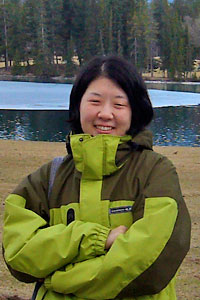Spring-Summer 2014
Life After Graduate School: The Postdoc Perspective
André Punt
Many SAFS PhD students continue their education after graduating by taking postdoctoral positions. Postdocs, whose official title is “research associate,” often are given their first opportunity to lead a research effort with limited supervision and, at SAFS, many of them are the engines that drive our research labs. Three current SAFS faculty (Gordon Holtgrieve, Julia Parrish, and I) were all postdocs here.
Given their integral role in the success of the school—and the fact that I stopped being a postdoc 20 years ago in June (!)—I decided to ask five current SAFS postdocs about their experiences here: Marine Brieuc [MB], supervisor Kerry Naish; Emily Howe [EH], supervisor Si Simenstad; Mei Sato [MS], supervisor Tim Essington; Athol Whitten [AW], supervisor André Punt; and Peter Westley [PW], supervisor Tom Quinn.
AP:What attracted you to SAFS?

Photo courtesy of Marine Brieuc
MB: The first time I came to SAFS was for an internship when I was a graduate student in France. At the end of my seven weeks here, my husband—Kotaro Ono (MS 2010, Simenstad, advising professor)—and I realized that this school had excellent labs for population, conservation, and quantitative genetics, and a great program in quantitative fisheries modeling. It was obviously the perfect place for us to be! By the time I finished my PhD, I knew how innovative the genetics labs here at SAFS were, and that they offered an excellent opportunity to further develop my skills and collaborate with amazing scientists. Of course, I was motivated to stay in Seattle as Kotaro is still working on his PhD (Ray Hilborn, advising professor).
EH: It started 13 years ago, when I came home from college in Vermont wanting to find ways to get into the salmon recovery and restoration world. I started as a volunteer in Si's lab in 2001; transitioned to an hourly tech, identifying fish gut contents; then had a two-year hiatus with The Nature Conservancy; and then came back as a Master's student, followed by my PhD studies. And now I'm a postdoc.

Photo by Maria Karm
What kept drawing me back to SAFS, however, was the inclusivity and family-like feel to the school. People across all levels—from students to techs to professors—work well together. The level of support that people are willing to give to one another, along with the free exchange of ideas, makes SAFS a very special place. The rigorous learning environment constantly exposes us to new ideas and new ways of doing things. The learning never stops as creative, brilliant minds keep filling the building each year. It is a very stimulating and supportive environment to work. I loathe the idea of ever leaving this community.

Photo courtesy of Athol Whitten
AW: The opportunity to work with leaders in the field of fisheries stock assessment modeling attracted me to SAFS. The school is recognized as a world leader in quantitative analysis of fisheries data and in stock assessment modelling, and it has strong links with NOAA scientists who specialize in those areas. Being at SAFS gives me a great opportunity to learn from the best.
PW: I transferred to SAFS after two years at a small liberal arts college in Oregon, as I was thirsty for hands-on aquatic research. I was accepted into the Aquatic Ecological Research in Alaska undergraduate course with the Alaska Salmon Program in 2003 and the event set my future career path on a new trajectory.

Photo by William Hauser
I continued on with my MS with Ray Hilborn, working in Alaska, then went to the Memorial University of Newfoundland for my PhD. Shortly before finishing my PhD, my wife, Donna Hauser (MS 2006 SAFS, VanBlaricom, adviser) enrolled in the PhD program at SAFS (Kirstin Laidre, adviser), so I was looking for employment in the Seattle area and fortunately was offered a postdoc with Tom Quinn.
AP:What have you been doing at SAFS?
MB:I am identifying regions of the steelhead genome that are involved in resistance to the Infectious Hematopoietic Necrosis Virus (IHNV). This is part of a multidisciplinary project that aims at developing a model for the emergence of IHNV.
EH:My main focus has been on using stable isotopes and fatty acids to ascertain food web connections in detritus-based marsh ecosystems. I have also been teaching at UW; most recently, I stepped in for Ray Hilborn this past fall to teach his Food and the Environment course. It was a good challenge and a great opportunity to refine my teaching skills.

Photo by Wei-Cheng Wang
MS:I am evaluating the potential effects of hypoxia on fish and zooplankton distributions and behavior in Hood Canal. I joined the monthly field survey for 2013 to characterize pre-, during, and post-hypoxia nekton distributions along the canal. I am examining how seasonal and interannual differences in the timing and intensity of hypoxia affects distributions of predators and prey. I am also organizing the EcoLunch Seminar Series to provide a forum for field- and laboratory-based talks about ecology, hoping to increase awareness of research within SAFS by sharing our interests.
AW:I have been working with NOAA to develop new stock assessment models and associated software for the North Pacific Fisheries Management Council. The models will be used to assess the status of highly prized Alaskan crab stocks. (AP – Athol is understating his skills – he also officiated at Sarah Espe’s wedding (SAFS Assistant to the Director, now Sarah Morrow).)
PW:I am working with Tom Quinn and Andy Dittman (NOAA) on various issues surrounding homing and straying of salmon and steelhead in the Columbia River Basin.
AP:What makes SAFS the place to be as a postdoc?
MB:SAFS is an excellent institution in part because of all the collaborations within and among our labs, and with numerous external organizations and agencies. Most postdocs are conducting their research in collaborations between SAFS and NOAA or the US Geological Survey (USGS). Also, being a postdoc in a university gives lots of opportunity for mentoring grad students or undergrads. Living in Seattle isn't too bad either!
EH:SAFS is the edge of the surf zone—where new thoughts, techniques, and revelations are being unveiled on a weekly basis. It is an incredible place from which to network—the number of connections to other researchers and agencies is unparalleled. We sit at an intersection where baseline science meets real-time management needs. We also have our finger, as a community, on the pulse of ecosystems from California to Alaska and beyond. There is a strong sense of connectivity that reveals itself through our collective work, ranging from inland headwater systems to the Alaskan Gyre.
MS:SAFS is the place to learn new techniques and gain knowledge that I didn't have access to during my graduate studies.
PW:Incredible academic freedom and support. The culture of interaction between students, postdocs, and faculty is inspiring and fun to be a part of! My experience at other institutions suggests that postdocs sometimes fall through the academic cracks...we are not students, staff, or faculty (technically)...but at SAFS we are treated as colleagues and receive lots of respect.
AP:What's next for you?
EH:I am a place-based person. This is something I've learned from working both in the Bay area and Puget Sound ecosystems. I want to live where I work so I can watch my ecosystem as it evolves through its annual cycles and across the years. I am attracted to agency work at places such as USGS, NOAA, or the Washington Department of Fish & Wildlife, but also really enjoy the rigors of teaching and independent research that are available through university settings. So, we'll see what pops up. One way or another, I'm tied to estuarine ecosystems, so that is where I will try to focus my work in the years to come.
AW:I'm looking to put my new skills and knowledge to work in a permanent scientist position, most likely back in Australia. Working at SAFS has cemented my desire to be part of the world's stock assessment modelling community and has given me a great launching pad from which to start a professional career.
PW:In July I will have begun a position as assistant professor at the University of Alaska Fairbanks in the School of Fisheries and Ocean Sciences. I am really looking forward to helping build stronger ties between SAFS and the UW and the University of Alaska.
AP:What do think your best memory of SAFS will be?
MB: That's a hard one. But if I had to pick one, I would say last year’s spring picnic, when we got to dunk the faculty and director! (AP: Now there is something I don’t recall happening when I was a postdoc….)
EH:The folks here and the adventures of field work. I have thoroughly enjoyed coming to work these past 13 years, and can only hope that I have as much enthusiasm for what I do in whatever my next position holds for me. The best things about SAFS folks, though, is that nothing deters them, and the work is always rewarding and fun, even when faced with frost-bitten fingers during midnight January tides.
AW:When I first arrived, André charged me with coordinating a team of 12 graduate students on a large research project. It was a huge challenge to lead a team of young researchers, but it was very enjoyable too. The results of our modelling and simulation studies were presented at the World Conference for Stock Assessment Methodology in Boston.
PW:The best things in life come from interactions with other people, and without a doubt, I will most remember the life-long friendships and collaborations that were forged here at SAFS.
